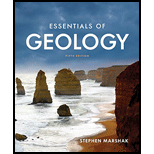
The usage of the term “Earth System” to describe the components of processes operating on this planet.
Answer to Problem 1RQ
The term “Earth system” deals with interaction between atmosphere, hydrosphere, cryosphere, geosphere, pedosphere, and biosphere reservoirs of the Earth.
Explanation of Solution
“The global interconnecting web of physical and biological phenomena on the Earth is termed as the Earth System”. The Earth system is a dynamic integrated system, which deals with the interacting physical, chemical, and biological processes.
At the surface of the earth, the interaction between many components of the earth system takes place; the lithosphere which constitutes the soil, sediment, and rock; the hydrosphere which constitutes the liquid water in oceans, lakes, streams, and groundwater; the cryosphere which constitutes the solid water of glaciers; and the atmosphere which constitutes the planet's gaseous envelope.
The biosphere denotes the innumerable species of life ranging from invisible bacteria to massive whales and trees. There are two dynamic exchanges of energy fuel that happens between the reservoirs of the Earth system; they include external energy from solar radiation and internal energy from the earth’s interior.
The reservoirs of the earth undergo change. The objective of the Earth’s system involves “global change which deals with the transformation of physical and biological components in the Earth system over time.” The type of change depends on the rate at which the change progresses, namely
- The change that takes place slowly for over a long geologic period (millions to billions of years) is called gradual change.
- The change taking place swiftly is termed as catastrophic change (seconds to millennia). For example, the catastrophic change in the biodiversity is a mass-extinction event.
- The change involving transformations that never repeat is called unidirectional change. For example, the evolution of solid earth.
- The change that involves repetition of the same step over and over again with a definite frequency is called periodic change.
Various materials cycle among living and nonliving reservoirs of the Earth system during the hydrologic cycle, the rock cycle, and various biogeochemical cycles such as the carbon cycle. The proportions of these materials held in distinct reservoirs of the Earth system can change over time.
In addition, climate change and sea level change have greatly affected the planet's surface. Plate tectonics continuously, but gradually, alter the map of the planet. And life and atmosphere have evolved over the geological history. In spite of its massive form, the Earth system has a fragile nature.
Anthropogenic activity has caused great changes in just a few hundred years. Some changes in the Earth system are cyclic, though not necessarily periodic. Examples include the supercontinent cycle that occurs by the collection of continents by collision, and then dispersed by rifting, the sea level cycle that deals with sea level fluctuations, and the rock cycle. During biogeochemical cycles, carbon, water, and other elements cycle through living and nonliving reservoirs. Some carbon may be trapped underground for geologic time.
Want to see more full solutions like this?
Chapter 19 Solutions
Essentials of Geology (Fifth Edition)
 Applications and Investigations in Earth Science ...Earth ScienceISBN:9780134746241Author:Edward J. Tarbuck, Frederick K. Lutgens, Dennis G. TasaPublisher:PEARSON
Applications and Investigations in Earth Science ...Earth ScienceISBN:9780134746241Author:Edward J. Tarbuck, Frederick K. Lutgens, Dennis G. TasaPublisher:PEARSON Exercises for Weather & Climate (9th Edition)Earth ScienceISBN:9780134041360Author:Greg CarbonePublisher:PEARSON
Exercises for Weather & Climate (9th Edition)Earth ScienceISBN:9780134041360Author:Greg CarbonePublisher:PEARSON Environmental ScienceEarth ScienceISBN:9781260153125Author:William P Cunningham Prof., Mary Ann Cunningham ProfessorPublisher:McGraw-Hill Education
Environmental ScienceEarth ScienceISBN:9781260153125Author:William P Cunningham Prof., Mary Ann Cunningham ProfessorPublisher:McGraw-Hill Education Earth Science (15th Edition)Earth ScienceISBN:9780134543536Author:Edward J. Tarbuck, Frederick K. Lutgens, Dennis G. TasaPublisher:PEARSON
Earth Science (15th Edition)Earth ScienceISBN:9780134543536Author:Edward J. Tarbuck, Frederick K. Lutgens, Dennis G. TasaPublisher:PEARSON Environmental Science (MindTap Course List)Earth ScienceISBN:9781337569613Author:G. Tyler Miller, Scott SpoolmanPublisher:Cengage Learning
Environmental Science (MindTap Course List)Earth ScienceISBN:9781337569613Author:G. Tyler Miller, Scott SpoolmanPublisher:Cengage Learning Physical GeologyEarth ScienceISBN:9781259916823Author:Plummer, Charles C., CARLSON, Diane H., Hammersley, LisaPublisher:Mcgraw-hill Education,
Physical GeologyEarth ScienceISBN:9781259916823Author:Plummer, Charles C., CARLSON, Diane H., Hammersley, LisaPublisher:Mcgraw-hill Education,





